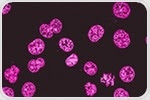|
|
| | January 7, 2019 | |
| | |
| | The latest fluorescence news from AZoNetwork | |
|
|
|
|
|
|
 |
| |
 Incorporating individual clear cups molded into either a black or white polypropylene matrix using a patented `two-shot` manufacturing process totally eliminates the well-to-well optical crosstalk inherent with other clear-bottomed microplate designs. Incorporating individual clear cups molded into either a black or white polypropylene matrix using a patented `two-shot` manufacturing process totally eliminates the well-to-well optical crosstalk inherent with other clear-bottomed microplate designs. | |
|
| |
 Cholesterol efflux from the peripheral tissues and cells in atherosclerotic plaque is a preliminary and critical step in Reverse Cholesterol Transport (RCT). RCT is the procedure by which extrahepatic cells, including macrophage-derived foam cells in arterial atherosclerotic plaque, carry unnecessary cholesterol back to the liver for bile acid synthesis and excretion, thereby lowering the peripheral lipid burden. Cholesterol efflux from the peripheral tissues and cells in atherosclerotic plaque is a preliminary and critical step in Reverse Cholesterol Transport (RCT). RCT is the procedure by which extrahepatic cells, including macrophage-derived foam cells in arterial atherosclerotic plaque, carry unnecessary cholesterol back to the liver for bile acid synthesis and excretion, thereby lowering the peripheral lipid burden. | |
|
| |
 Both fluorescence microscopy and light microscopy represent specific imaging techniques to visualize cells or cellular components, albeit with somewhat different capabilities and uses. At its core, fluorescence microscopy is a form of light microscopy that uses many extra features to improve its capabilities. Both fluorescence microscopy and light microscopy represent specific imaging techniques to visualize cells or cellular components, albeit with somewhat different capabilities and uses. At its core, fluorescence microscopy is a form of light microscopy that uses many extra features to improve its capabilities. | |
|
| |
 In vivo fluorescence microscopy is an imaging technique that uses fluorescence to image cells within live organisms. This type of microscopy provides highly accurate results and allows for the observation of the development of certain processes. In vivo fluorescence microscopy is an imaging technique that uses fluorescence to image cells within live organisms. This type of microscopy provides highly accurate results and allows for the observation of the development of certain processes. | |
|
|
|
|
|







No hay comentarios:
Publicar un comentario